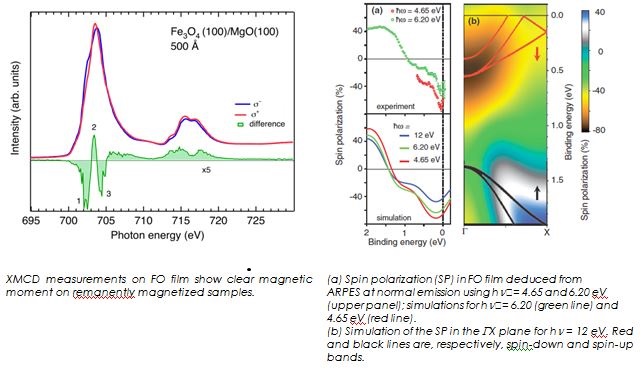
|
|
|

|
|
Fe3O4
|
We studied the electronic structure of Fe3O4 (FO) that is supposed to have half-metallic properties. Results found in literature are until now controversial. Half metals have been the subject of intense research because they have a metallic behaviour for one spin orientation but a semiconducting behaviour for the opposite one. Thus, since only electrons with one kind of spin are present at the Fermi level, the absolute value of the spin polarization is awaited to be 100% in absence of spin-orbit interaction. This makes excellent candidates to generate/filter highly spin polarized currents. Angle and spin-resolved photoemission measurements performed on these films indicate that despite intrinsic electron-lattice (polaron) interaction a Fe t2g band dispersion can be observed, as well as a Fermi surface [Wang2013]. In our photoemission experiments, besides conventional radiation sources we used also the Ti: sapphire laser source (4.65 and 6.20 eV photons) thus turning this technique into a more bulk sensitive method, which is of importance for studying our interfaces. The state close to the Fermi level show a spin polarisation of up to -72% as measured with 4.65 eV laser light. The variation of spin polarization between 6.2 and 4.65 eV photon energy can be explained mainly by an increase of the inelastic mean-free path when lowering the photon energy.

All the data can be simulated starting from CGA+U bulk band-structure calculation and taking into account the polaron and initial-state lifetime broadening involved in the photoemission process. As in the case of LSMO, our studies conciliate the electronic structure of FO with a band model and confirm its half-metallic nature.
[W. Wang et al. PRB 2013]In further continuation of work on FO we were interested in time- and spin- resolved dynamics of electrons. These results are exposed more in detail in the section “Faits marquants”.